XP67_Moonbat
ACCESS: Top Secret
- Joined
- 16 January 2008
- Messages
- 2,259
- Reaction score
- 461
Heres a JAXA brief regarding future hypersonic and space launch projects.
The H-2B, which is designed to be launched once a year, is 56.6 meters high and weighs 531 tons, making it the largest rocket in the history of Japanese space development.
The cargo vehicle, weighing in at 4.6 tons, is carrying such supplies as food and other daily necessities, a water tank for feeding killifish and a device for releasing small satellites into space, the space exploration agency said.
The H-2B was jointly developed by JAXA and Mitsubishi Heavy for the purpose of carrying the Kounotori, which has a payload capacity of 16.5 tons. The rocket is twice as effective as H-2A rockets at launching satellites into orbit, JAXA said.
JAXA plans to develop a "homing version" of the Kounotori that will be used to return ISS equipment to Earth, JAXA officials said.
Like the H-2A, the country's mainstay rocket, the H-2B's first and second components are propelled through the reaction of liquefied hydrogen and liquefied oxygen.
Following the decommissioning last year of U.S. space shuttles, the Kounotori has been gaining international attention as a means of transporting large payloads into space, JAXA said.
The successful launch of an H-2B rocket Saturday boosted the combined success rate of H-2A and H-2B rockets to 95.8 percent, indicating the nation's satellite launch technology is now set to take off.
Future launches of the domestically produced rockets will be handled by Mitsubishi Heavy Industries Ltd., the rockets' manufacturer, as opposed to previous launches managed by the Japan Aerospace Exploration Agency. The nation is now set to become a major player in the field of commercial satellite launches.
With a current lineup of its core H-2A product and the latest H-2B, MHI will aim to win orders for commercial launches of foreign satellites. However, competition is tough in the market, particularly with foreign rivals....
....So far, MHI has won only one order, to launch a South Korean satellite with the H-2A rocket in May. The company still mainly relies on the Japanese government for launch orders....
Archibald said:Something that puzzle me in the history of space flight is the switch to LOX/LH2 engines in the 70's - LE-7 and Vulcain, SSME and RS-68 later. Without blaming the shuttle for everything-that-gone-wrong-with-the-space-program, was the SSME the reason for that ?
I mean, LH2 is good for upper stages, but unless you have the Aerojet M-1, kerosene sounds better for first stages.
Quindar Beep said:...
If you'd like an executive summary of the executive summary, I've just finished putting it all together with the other hints and allegations about it that I've heard over the years and sticking it up on my blog: https://falsesteps.wordpress.com/2012/10/10/fuji-bringing-the-mountain-to-the-masses/
KAMAKURA, Kanagawa Prefecture--Mitsubishi Electric Corp. unveiled its new 3 billion yen ($30 million) facility for the construction of satellites at its Kamakura Works here on April 12.
Scheduled to be fully operational in late May, the satellite construction complex is expected to double Mitsubishi Electric's combined production capacity to eight units a year as it expects to win more orders from overseas.
"We plan to raise sales of the space business to 150 billion yen in 2020 from the current 70 billion yen by winning two orders from overseas annually," said Masamitsu Okamura, who heads the Kamakura Works.
The six-story facility, with a total floor space of 7,817 square meters, is capable of producing four units simultaneously, according to the company.
The heart of the complex is the "clean room," a section about 30 meters square and 19 meters tall, where temperature and humidity is controlled and fine dust is shut out.
Mitsubishi Electric is the nation's leader in the production of satellites.
The domestic market for satellites--four to five units a year--is dominated by Mitsubishi Electric and NEC Corp.
Mitsubishi Electric became the first Japanese manufacturer to build a commercial satellite for a foreign client after receiving an order from a Singaporean business in 2008.
The global market for satellites is estimated at around 1 trillion yen annually. The sum is the equivalent of 20 to 25 satellites.
By TAKASHI KAMIGURI/ Staff Writer
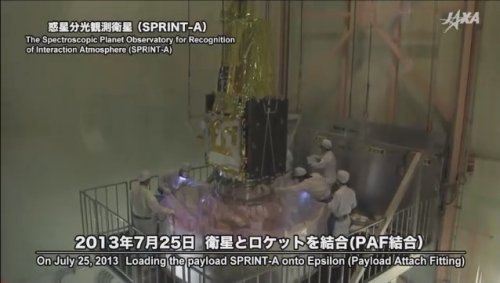
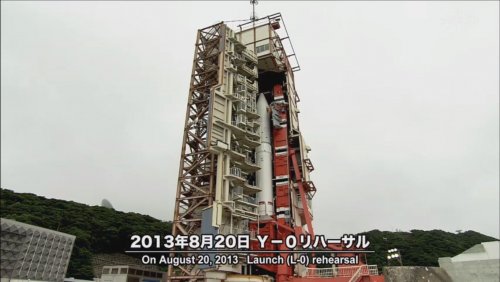
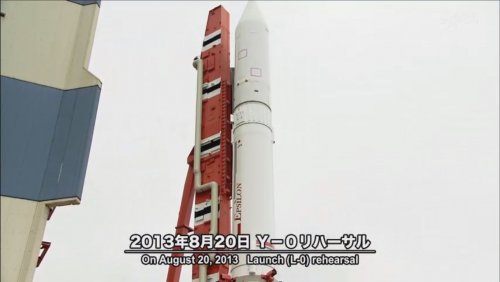
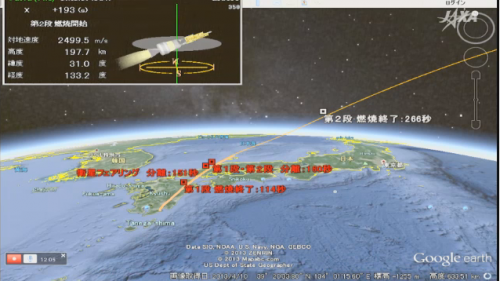
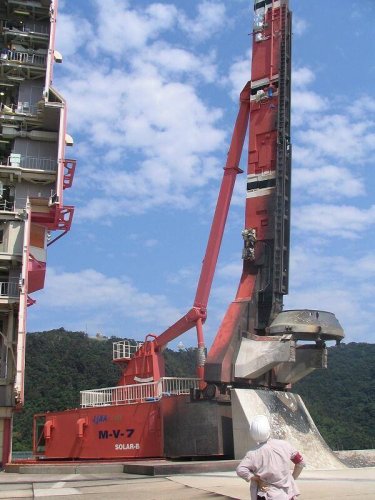
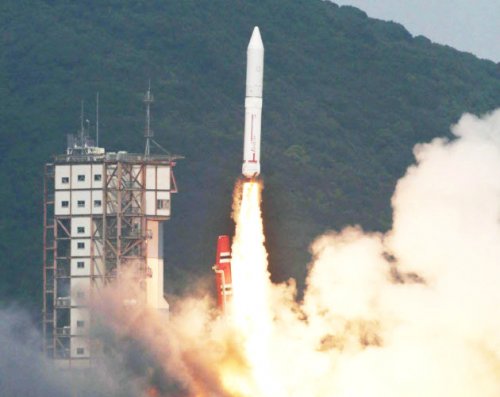
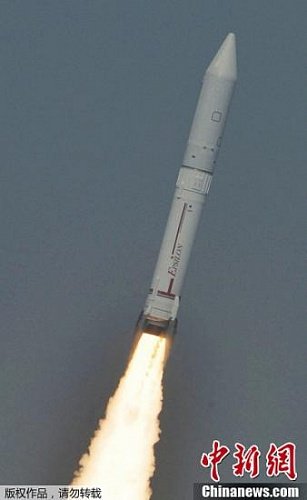
Just? Epsilon's predecessor already fit that description very well - pretty much a Peacekeeper.Orionblamblam said:The fact is probably lost on nobody that what Japan just demonstrated is a pretty dandy ICBM. Solid propellant, fast-reacting, minimal crew, decent throw weight.
Trident said:Just? Epsilon's predecessor already fit that description very well - pretty much a Peacekeeper.Orionblamblam said:The fact is probably lost on nobody that what Japan just demonstrated is a pretty dandy ICBM. Solid propellant, fast-reacting, minimal crew, decent throw weight.
The black smoke at the time of rocket fire is the injection smoke of the strap on booster used for the postural stabilization of a rocket.sferrin said:What's the deal with the black smoke there at the beginning? Solid gas generator? ???

One giant leap for Pocari Sweat--sports drink set for 2015 moon landing
May 16, 2014
By TOMOYUKI IZAWA/ Staff Writer
When future astronauts walk on the moon it won't be Tang they will be drinking to quench their lunar thirsts, if the makers of Pocari Sweat have anything to say about it.
Otsuka Pharmaceutical Co. announced May 15 that its popular sports drink with the unusual name will be hitching a ride on a rocket bound for the moon in October 2015.
Otsuka Pharmaceutical's Pocari Sweat division came up with the idea after they heard reports by U.S. scientists last year claiming that the moon likely has sources of water.
A canister of powdered Pocari Sweat concentrate made to resemble a can of the sports drink sold in vending machines will be left on the lunar surface, and all the future Neil Armstrongs have to do is add water, according to company officials.
The canister will be made of titanium to withstand the extreme temperatures of the lunar surface, which can hit 110 degrees during the day and plummet as low as minus 180 degrees at night. A plaque with the hopes and wishes of 38,000 children engraved on it will accompany the canister of Pocari Sweat.
The rocket, sponsored by a private company, will be launched from Florida and make the 384,400-kilometer trip to the moon in about four and a half days. A lunar lander will transport the canister to the moon's surface.
"We want our use of the moon to set an example," said an Otsuka Pharmaceutical official, referring to the fact there are no laws or regulations regarding the use of the lunar surface. "We will not damage the lunar environment."
Otsuka Pharmaceutical has been a forerunner in the field of space advertising, shooting the world's first "space commercial" at the International Space Station in 2001.
By TOMOYUKI IZAWA/ Staff Writer
11:22 pm, September 08, 2014
The Yomiuri Shimbun
The Defense Ministry has come up with a basic plan for the use of space for national security purposes that features the establishment of a special unit tasked with monitoring space debris and keeping tabs on other countries’ antisatellite weapons.
After the government incorporated “Use of Outer Space” into its National Security Strategy, compiled late last year, the ministry began revising the Basic Guidelines for Space Development and Use of Space that were compiled in 2009.
Under the new policy, unveiled to the Liberal Democratic Party’s National Defense Division on Thursday, the ministry stressed the importance of a mission to keep track of space debris, such as fragments of satellites and rockets no longer in use, to protect communications satellites and other devices directly related to Self-Defense Forces activities.
As collisions with space debris could cause serious damage to satellites, the ministry plans to launch a unit within the ministry or the SDF to work closely with the Japan Aerospace Exploration Agency (JAXA), which currently monitors space debris with a radar system deployed in Okayama Prefecture, as well as with U.S. forces.
The ministry also plans to test infrared sensors for the first time in space to detect signs of ballistic missile launches by North Korea. With the sensors to be installed on a cutting-edge optical satellite, the test is intended to check the sensor’s ability to detect the heat from missile launches.
[snip]
Govt eyes development of expendable satellite
The government will start full-fledged discussions in next fiscal year on the development of an expendable small observation satellite, which could be launched immediately in such eventualities as a natural disaster or a military emergency, it has been learned.
The new satellite could be used for rescue and information-gathering activities, according to government sources.
The envisaged satellite is referred to as an operationally responsive small satellite. Its development is included as a subject for discussion in a draft of the Basic Plan on Space Policy, which was released in autumn by the government’s Committee on National Space Policy.
A preassembled satellite, measuring 70 centimeters in length, width and height, would be launched with a camera and other equipment in case of emergency. It weighs from 100 kilograms to 150 kilograms.
The satellite would fly at a relatively low altitude of 200 kilometers to 300 kilometers, half that of an ordinary observation satellite, to observe a targeted area in detail. The satellite would burn up upon reentering the atmosphere about a week after launch.
The government plans to establish a working group jointly with the Cabinet Office, the Education, Culture, Sports, Science and Technology Ministry and the Defense Ministry.
Currently, Japan possesses the Daichi-2 Earth observation satellite and information-gathering satellites, but does not have enough satellites to observe specific areas thoroughly. The government will discuss using expendable small satellites to cover the shortage.
Japanese team wins 'milestone award' for lunar rover development
January 28, 2015
By RYUTA KOIKE/ Staff Writer
A Japanese private-sector team was one of five entries to receive a special prize to develop an unmanned lunar rover by sponsor Google Inc.
The Hakuto team, the lone Japanese entry, announced Jan. 27 that it received the "milestone award" for $500,000 (60 million yen) in the multimillion-dollar Google Lunar XPRIZE competition.
The funds will go toward further developing and refining the rover, which is required to be launched to the moon by the end of 2016.
The Hakuto lunar rover is being developed by a team led by Kazuya Yoshida, a professor of aerospace engineering at Tohoku University who helped create the Hayabusa asteroid probe.
The team of researchers and venture-capital entrepreneurs earned the milestone award after the Hakuto rover passed mobility tests held between November and December.
The milestone awards are part of $30 million in total prize money being offered by Google.
Eighteen teams from various nations are taking part in the competition.
Each team must develop its rover for launch by the end of 2016. Once the rover lands on the lunar surface, it must travel more than 500 meters and transmit video images back to Earth.
By RYUTA KOIKE/ Staff Writer

